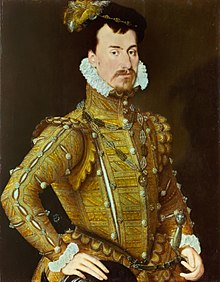On Sunday September 8th 1560, 460 years ago, Lady Robert Dudley, who had insistently sent all her household off to Abingdon Fair that day was found upon their return to Cumnor Place lying dead with a broken neck and two head wounds at the foot of a staircase.
Lord Robert Dudley circa 1560
Image:Wikipedia
It was a death with significant consequences - the likelihood of her widower Lord Robert Dudley marrying Queen Elizabeth I was rendered virtually impossible. Whatever the Queen’s intentions or feelings towards Lord Robert, whom she was to create Earl of Leicester in 1564, and his towards her, their marriage, and possible heirs, there was not to be. He remained very much her favourite until his death in September 1588. He seems at times himself to have been uncertain as to what their relationship was, not least when she was apparently keen to marry him off to Queen Mary in Scotland in 1564 or when he sought to marry in the 1570s. It can perhaps be seen as an amitie amoureuse but a strangely manipulative one. It was also a political alliance. Modern scholarship is more generous in its assessment of Leicester than has been the case in the past.
Wikipedia has useful biographies of the Dudleys at Amy Robsart and at Robert Dudley, 1st Earl of Leicester Both of these give insightful extracts from material about the death.
There is more about Amy herself at Looking for the Real Amy Robsart
Cumnor Place itself, alas, eventually decayed and was demolished in 1810. Some have claimed this was because of the troubled ghost of Lady Robert haunting the building. There is a detailed account of the house - which was clearly of considerable architectural interest - as well as of the events there in September 1560 at Cumnor Place
Cumnor Place in 1805
The documents relating to the inquest were rediscovered in 2008 and the Coroner’s Report can be seen at Coroner’s report
The websites I have linked to above outline the arguments around the death of Lady Robert Dudley. It remains a popular topic for speculation and theorising online, as well as academic research.
It strikes me that the contemporary received account too obviously points to her husband as the person ultimately responsible: however he appears to have been genuinely surprised by the news and any plans or hoped he did have to marry the Queen were more or less completely scuppered. As Amy was so anxious to have the house empty it looks as if she was expecting someone, and a coincidental accidental death appears unlikely. One possibility is indeed that one of Dudley’s opponents was determined to wreck his chances. The other might be that someone in his entourage, such as Sir Richard Verney at whom the finger of suspicion was pointed by some, thought he was doing his master a good turn by eliminating an inconvenient wife who might soon be dead anyway...
Writing this post makes me realise I ought to read Chris Skidmore’s Death and the Virgin: Elizabeth, Dudley and the Mysterious Fate of Amy Robsart, published in 2010,which has had very good reviews.
It may of course, that this really is a case where truth, were we ever to discover it, might be stranger than fiction.



No comments:
Post a Comment